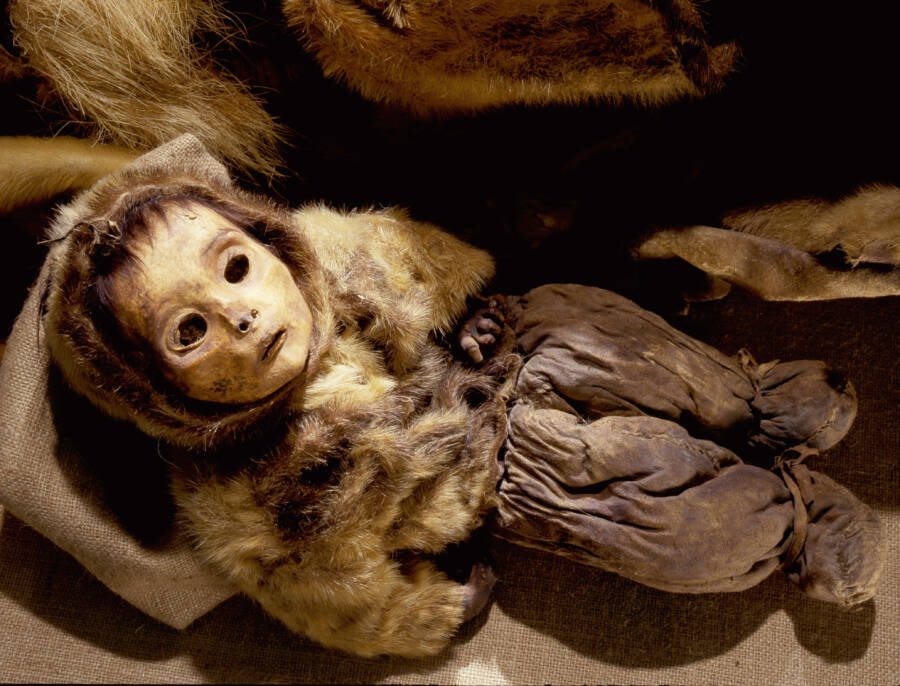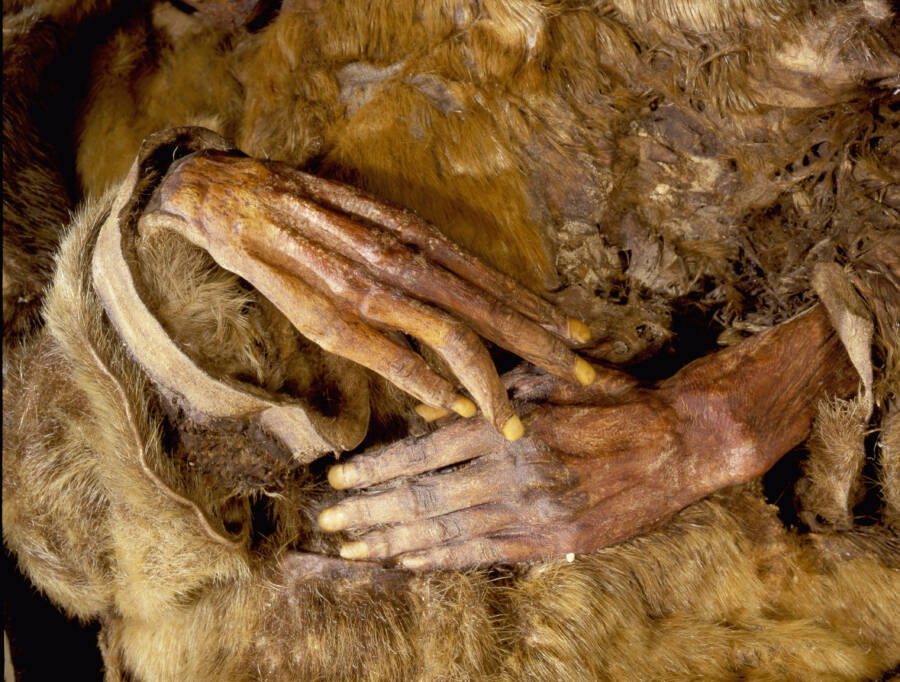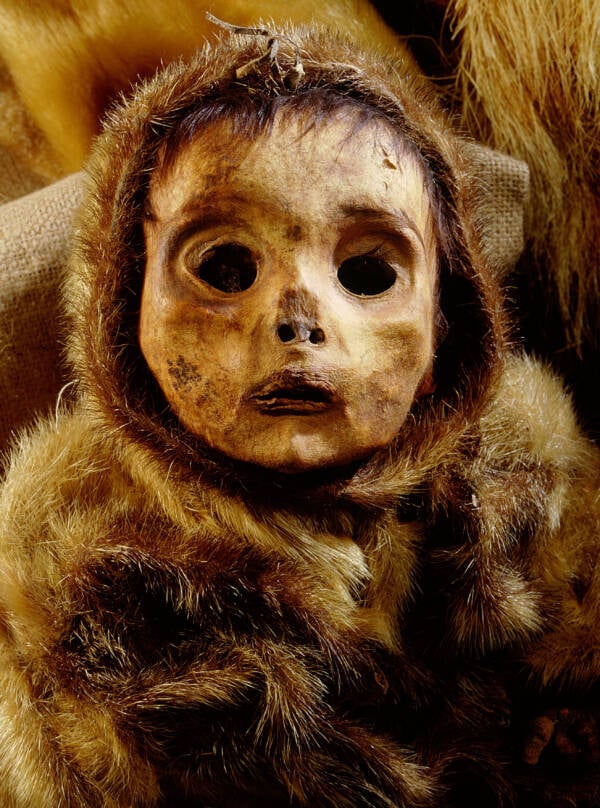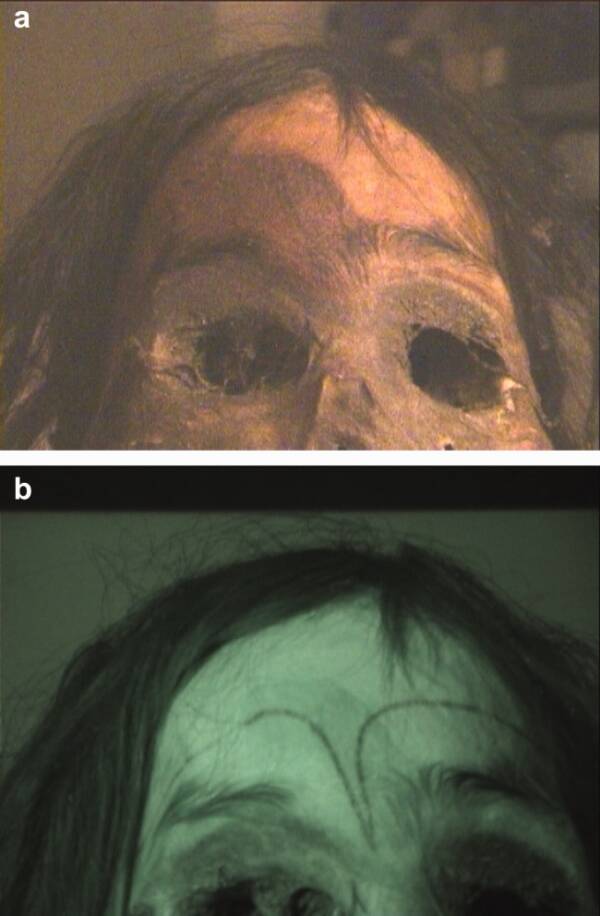When two brothers stumbled upon the 500-year-old Inuits in 1972, they thought they'd discovered a recent burial.

Werner Forman/Universal Images Group/Getty ImagesThis Thule Inuit infant is one of the Qilakitsoq mummies, a 500-year-old corpse so well-preserved that its hair, skin, and nails are all intact.
In 1972, eight Qilakitsoq mummies were discovered in two tombs within a rocky crevasse in Greenland. This was, of course, not the first time researchers came across ancient mummies, but these were some of the best-preserved specimens ever found in Greenland.
The skin, fingernails, hair, and even eyebrows of the six adults and two young Inuits are plainly visible. They came to be known as the Qilakitsoq mummies for the abandoned Inuit settlement in which they were discovered, on the Nuussuaq Peninsula in northwestern Greenland.
The mummies were likely simple farmers and their mummification accidental. The subzero temperatures on the Greenland peninsula had naturally preserved the corpses, freeze-drying them against time. They were, in fact, so well-preserved that their organs could be examined and even their tattoos were visible.

Werner Forman/Universal Images Group/Getty ImagesHand detail from one of the group of six women and two children all buried at the same grave site.
Perhaps most shocking about the discovery was that the youngest corpse, a six-month-old, appeared to have been buried alive.
The Initial Discovery Of The Qilakitsoq Mummies
Brothers Hans and Jokum Grønvold were hunting grouse when they happened upon the Qilakitsoq mummies under some rocks in 1972.
The corpses were stacked vertically with layers of animal hide between them. They still wore the furs that would have kept them warm during life in preparation for the hunt Inuits believed they would experience even in the afterlife.
It is believed that the Qilakitsoq mummies remained so well preserved because of the Arctic climate: freezing ground temperatures coupled with extremely dry air effectively freeze-dried the corpses, preserving their skin and innards for centuries.
Of the eight bodies, the infant was the best-preserved which archaeologists attribute to his size: he would have frozen must faster than his family members beside him.

Werner Forman/Universal Images Group/Getty ImagesOne of the adult mummies from Qilakitsoq wrapped in a traditional fur.
Along with the bodies, the brothers discovered 78 additional pieces of clothing fashioned from reindeer and sealskin. After they alerted authorities, archaeologists then found a few other graves and the remains of abandoned homes at the Qilakitsoq settlement as well.
Archaeologists learned that three of the adult mummies were sisters. Buried with them were their children: an 18-year-old-daughter, a two to four-year-old son, and a six-month baby boy who was alive when buried with his mother.
Thule Inuits believed that burying the mother and child together would ensure that they entered the afterlife together. Indeed, a peaceful journey to the land of the dead was of utmost importance for this tribe. Further, it was believed that burying the baby with its mother avoided the infant’s likely inevitable, and more painful, death by starvation.
Testing revealed that the older son likely had a variation of Downs Syndrome. Thule custom dictated that this child was also likely buried alive, but sources differ on whether this was the case with this particular mummy.
The second grave contained the three women; two of which were related, and one who appeared to be unrelated to anyone else at the gravesite. It’s thought that she may have married into the family of the others buried beside her.
It became clear to researchers that the family had received a traditional Inuit burial in local rock formations. Their placement also helped to preserve them as it provided ample drainage, airflow, and sufficient protection from the weather.
What Scientists Learned From The Corpses

Werner Forman/Universal Images Group/Getty ImagesWhen first discovered, this six-month-old baby was mistaken for a doll.
These mummies would prove to be an invaluable tool for understanding the customs of Greenland’s indigenous Thule Inuit population.
Though the family was likely buried around 1475 A.D., their forefathers settled in the area about 500 years prior.
Scientists are not completely sure how exactly the adult Inuits died, but they speculate that it was perhaps due to natural causes like kidney stones, tumors, constipation, and overall poor health.
Archaeologists found large amounts of soot in the lymph nodes of the lungs of all the mummified remains. This can be attributed to using lamps lit by seal oil in the small confines of their homes.
The Qilakitsoq mummies also were heavily infested with lice. They were so infested, in fact, that scientists recovered remnants of lice from some of their intestines, which indicated that the lice on their bodies had gotten into their food as they were eating.
UV-examination showed that all the women’s foreheads, eyebrows, and chins were adorned with tattoos made by pulling soot-dipped sinew through the skin with a needle. Tattoos like this likely denoted each woman’s tribal and familial relationships and would have been given to them at puberty and marriage.
Indeed, the young female mummy did not have tattoos. This may indicate that she was either unmarried or had not yet gone through puberty.

Anatomy PubsIt is difficult to see the tattoos in the top photo of one of the Qilakitsoq female mummies, but in the bottom, using InfraRed light, it is visible.
Scientists found moss and other plant life in one of the mummy’s intestines, suggesting that they ate plants as a supplement to their otherwise meat-heavy diet. More than 75 percent of the meat they ate consisted of marine mammals and fish, the rest likely came from reindeer and other game.
These mummies were instrumental in advancing the field of mummy studies for their impeccable preservation.
A Brief History Of The Thule Inuits
Before settling in Greenland, the Thule Inuits came from other areas of the polar north. They sailed around the coasts of Greenland in their boats called umiaks which were made from driftwood and seal skin. They constructed their homes from a similar combination of terrestrial oceanic materials, namely whalebone, and stone.
They brought with them entire households of goods, including their dogs and sleds which were their main form of winter transportation. Though the Thule were spread throughout the Arctic island, they were a unified people that spoke the same language, though in different dialects, and followed the same traditions.

Timkal/Wikimedia CommonsRemnants of a Thule dwelling made of whalebone.
There are accounts of Norse explorers encountering the Thule in Greenland around about 1200 A.D. There are documents regarding their subsequent trade agreements. The Nordic explorers likely traded their iron for Thule ivory made of walrus tusk.
But as is typical of history, these trade deals often involved conflict too. The Norse traders observed that: “When they [the Inuits] are struck by weapons, their wounds are white, with no flow of blood…but when they die, the bleeding is almost endless.”
Other Notable Mummies From Greenland And Around The World

Toke/FlickrOne of the Qilakitsoq mummies on display at the Greenland National Museum.
The first major mummy discovery in Greenland came in 1945. Three mummies were initially found near Nuuk, and three additional mummies were found in 1952 in the same location.
These corpses ranged in their completeness. Some were intact, others were dismembered and still others had only partial extremities remaining.
Some of the world’s best-preserved mummies include a 500-year-old Inca maiden found in the Andes Mountains in 1999, and Lady Dai of China, nicknamed “Sleeping Beauty,” who is 2,000 years old.
There is also Rosalia Lombardo, a mummified Sicilian toddler who died in 1918, who still appears so lifelike that some swear she can blink on a regular basis.

Wikimedia CommonsRosalia Lombardo, the sicilian mummy toddler some swear can still blink.
The study of ancient mummies is a race against time that pits disintegration against scientific development, and so finds like the Qilakitsoq mummies are invaluable.
Four of the Inuit mummies are on display at the Greenland National Museum.
After this look at the Qilakitsoq mummies, read about the ghoulish salt mummies pickled in time in Iran. Then, find out about the pre-Egyptian Bog Bodies also mummified by nature.





